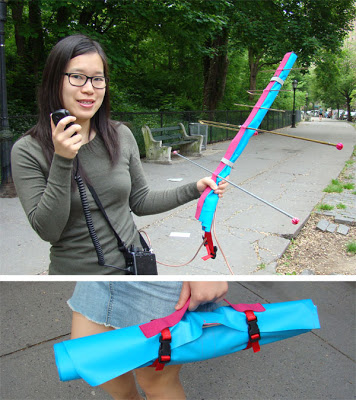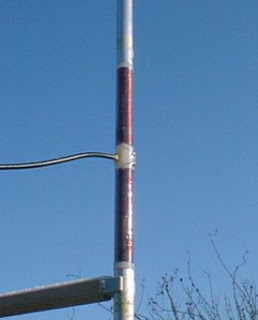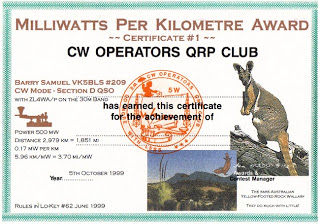A pointer to the classic Hancock episode, ‘The Radio Ham’.
Painfully hilarious!
A pointer to the classic Hancock episode, ‘The Radio Ham’.
Painfully hilarious!
G4ILO has some interesting observations and speculation about recent 10m openings in his part of the world. He wonders whether they might be scatter off the clouds of volcanic ash drifting to Europe from Iceland.
Via M1KTA’s blog a pointer to Christophe F4DAN’s exhaustive list of SDR projects.
What an amazing resource! It feels like the distillation of many hours of research and study.
Really valuable information in here. It was last updated at the end of March. Also available in ‘une version française‘.
There’s been a great explanation posted on the Buddipole list about the practicalities of using the A123 battery packs Buddipole sell from their site.

The advantages of the A123 chemistry are low weight, fast charge times and ability to deliver high current. As well their voltage – 13.2v for a four cell pack such as the one shown – is well-suited to modern amateur radio gear.
The email exchange is yet another example of how an innocent newbie’s question can draw out the best information which benefits the broader group. Mark KD5RXT’s explanation of duty cycle and the unique qualities of this new battery chemistry are almost text-book ready!
I’m still keen to find out more about the selection of the best solar cell and charger system to keep such a battery topped up. I sense that a system that could take advantage of its fast charge rate might dwarf the rest of the radio gear. And I also sense that current portable solar panels, especially the expensive roll-up ones might barely keep track even at QRPp levels.
News this morning from Apple that the delivery date for iPad (both WiFi & 3G) – in Australia – is 29th May.

I’m so looking forward to seeing how an iPad might fit into a portable QRP operation. Or even a remote one. I’m also hoping that Apple will retain enough of open protocols so that the device does not simply become an expensive personal front end to whatever shops they wish to set up, like the sadly not ready for primetime Kindle.
Lack of a camera on the iPad is odd – given the next iPhone will actually have two – one in the front as well as the existing one on the back. Bluetooth keyboard sounds like it could be fun. I also imagine that ham radio apps to track satellites (ProSat) and monitor solar activity (Space Wx, 3D Sun etc) should look amazing. A work colleague showed me his new Android phone with a graphically brilliant astronomy application that you could use to locate, stars, planets and constellations easily. It felt like visual velvet and the images were much richer than I’ve seen so far on the iPhone.
Even a straighforward app to display bandplans should be able to be made to look clear and brilliant and enable you to get different views depending on mode, QTH or licence class.

I stumbled on to a page on Wikipedia about Friedrich Clemens Gerke, (22 Jan 1801 – 21 May 1888) the man responsible for simplifying Vail and Morse’s original telegraphic code.
As the wikipedia article explains, “The original Morse code consisted of four different hold durations (the amount of time the key was held down), and some letters contained inconsistent internal durations of silence. In Gerke’s system there are only “dits” and “dahs”, the latter being three times as long as the former, and the internal silence intervals are always a single dit-time each.”
This chart reveals the logic behind his reform of the code.

After some minor changes it was standardised at the International Telegraphy congress in Paris in 1865.
Via Southgate News and MAKE magazine news of a collapsible fabric yagi antenna developed by Diana Eng KC2UHB who has combined two craft skills in a stylish way, electronics and sewing. It’s a design for a Yagi for portable amateur radio satellite operation.

Her MAKE magazine article is well-written, comprehensive and brilliantly illustrated.
Diana Eng has also written an earlier article aimed at newcomers to amateur satellites for MAKE that covers:
Check the size of the antenna in that earlier piece and you’ll understand why she aimed at something more portable!
This page has a listing of how different alphabets and accented characters are sent with morse including Russian, Greek, Hebrew, Arabic, Japanese and Korean. I feel an overwhelming urge to change it from its dots and dashes layout to a didah format to reinforce the sound and not the visual structure of the characters. As comprehensive as these charts are, I’m still a little in the dark about some accents used in Portuguese. It could be that they’re simply not used in morse. Maybe listening to QSOs is the only way to confirm this.
Even the listing on the Portuguese Wikipedia page is missing the ã character. And this Brazilian page makes no mention of accented characters, even though it does explain that the codes for each character reflect their frequency in English.
Great BBC story on morse code from 2008, mentioned on the FT817 email list by Joe WB7VTY:
“Beware the Jabberwock, my son!
The jaws that bite, the claws that catch!
Beware the Jubjub bird, and shun
The frumious Bandersnatch!”
But make sure to check out the new training section on the SKCC site featuring mp3 files prepared by John KF7BYU.
So far the following texts are online, some in speeds ranging from 5 up to 50 wpm, along with text files:
The War of the Worlds, The Gettysburg Address, The Jabberwock, The Night Before Christmas, Hams Christmas and The Raven.
Via Julian G4ILO I came across a WSPRnet report from DM1RG on his success with a newly built KGD Antenna from the German site QRP Project. I had actually ordered their other antenna project (a Multiband Fuchs antenna that enables a single 41m wire to operate on all 8 HF bands) a few days ago and earlier tonight revisiting their site I was readng more about the KGD antenna – a very small vertical dipole – how’s 130cm for a 30m antenna that enabled a link from D to VK on 5 watts?

The Kurz Geratener Dipol antenna is no longer available as a kit but the instructions are still online – auf deutsch. I should also have a go at translating the manual. It seems to be quite an effective design. On the 40m version (pictured here from the QRP project site) – all 150cm of it – the bandwidth between SWR 2:1 points is 45kHz.
Reading about the antenna again on the same evening is clearly some kind of good omen? I can almost imagine one mounted bike mobile!
See the KGD antenna page for more detailed construction information.
I rejoined the CW Operator’s QRP Club Inc. after a long absence. I was surprised to discover I’m entitled to my original membership no #56. It’s probably been almost two decades.

I have fond memories of the Lo-Key magazine, but I’m also keen to have a go at the club’s Milliwatts per Kilometre Award! 10,000km on 5W or 1,000km on 500mW!